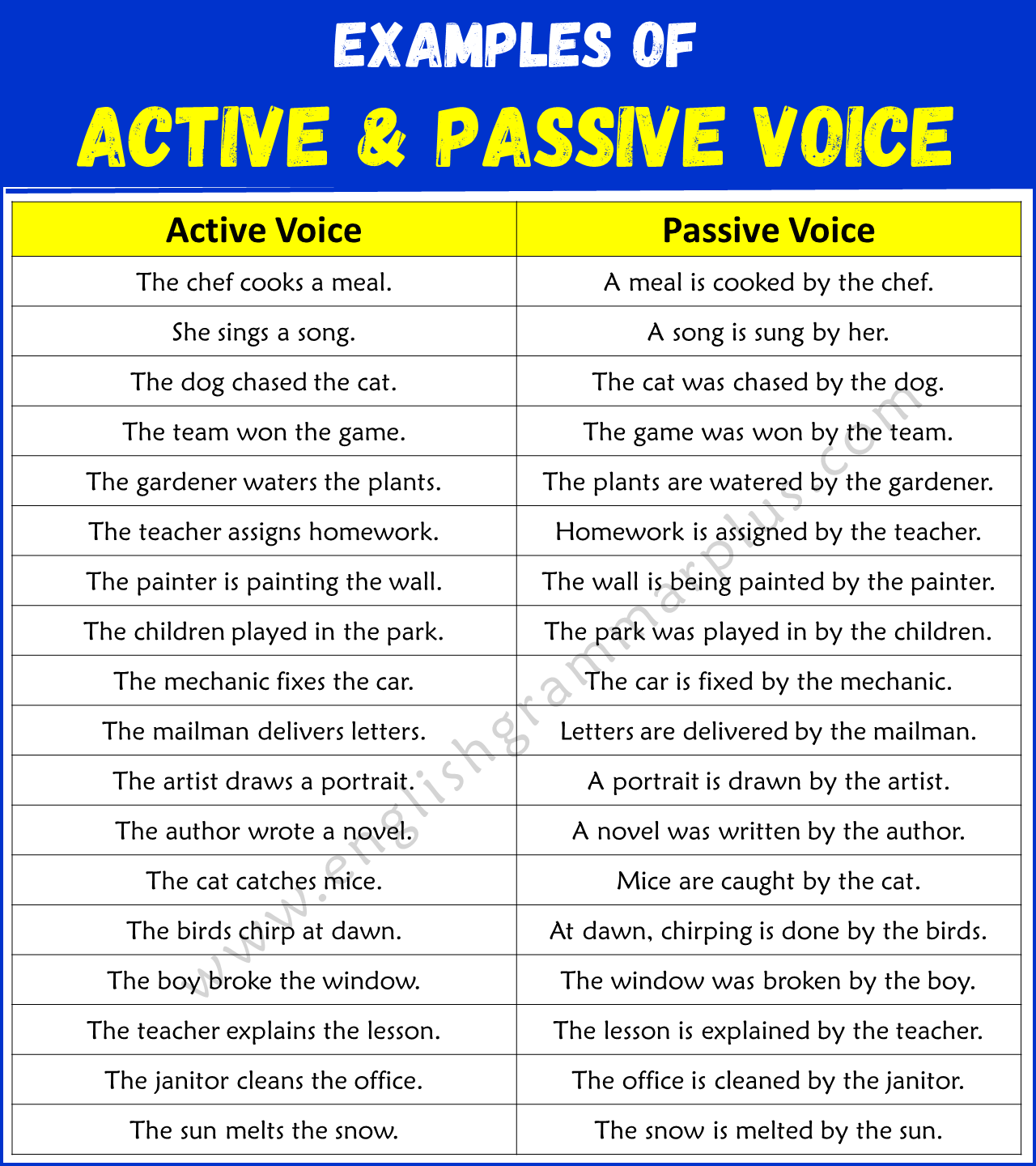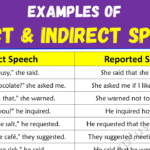In this lesson, we’ll look at active and passive voice in English. Active voice is when the subject does the action, like “I eat an apple.” Passive voice is when the action happens to the subject, like “The apple is eaten by me.” This is great for beginners or those who want to get better at English. Let’s keep it simple and start learning these important parts of speaking and writing in English.
Rules to Make Active and Passive Voice
Active Voice: In active voice, the subject performs the action expressed by the verb. The structure is straightforward: Subject + Verb + Object. For example, “The cat (subject) chased (verb) the mouse (object).”
Passive Voice: In passive voice, the subject receives the action. The structure changes to: Object (as subject) + Form of “be” (am/is/are/was/were) + Past Participle of the Verb + by + Original Subject. For example, “The mouse (object as subject) was chased (form of ‘be’ + past participle) by the cat (original subject).”
To Convert from Active to Passive Voice:
- Identify the Subject, Verb, and Object: First, figure out who is doing the action, what the action is, and who receives the action in the active sentence.
- Switch the Object and Subject: Move the object of the active sentence to the subject position in the passive sentence.
- Change the Verb: Use the appropriate form of “be” (depending on tense) followed by the past participle of the main verb.
- Add the Original Subject with ‘by’: Include the original doer of the action after ‘by’ if necessary for clarity or emphasis.
- Adjust the Tense: Ensure that the tense remains consistent during the conversion from active to passive voice.
Examples Across Different Tenses:
- Simple Present: “The chef cooks the meal.” becomes “The meal is cooked by the chef.”
- Simple Past: “The teacher praised the student.” becomes “The student was praised by the teacher.”
- Future: “The author will write a new book.” becomes “A new book will be written by the author.”
- Present Continuous: “The artist is painting a mural.” becomes “A mural is being painted by the artist.”
- Past Continuous: “The gardener was watering the plants.” becomes “The plants were being watered by the gardener.”
Remember, not every sentence should be converted to passive voice; use it selectively to emphasize the action or when the doer is unknown or irrelevant.
Examples of Active and Passive Voice
- Active: The chef cooks a meal.
Passive: A meal is cooked by the chef. - Active: She sings a song.
Passive: A song is sung by her. - Active: The dog chased the cat.
Passive: The cat was chased by the dog. - Active: The team won the game.
Passive: The game was won by the team. - Active: The gardener waters the plants.
Passive: The plants are watered by the gardener. - Active: The teacher assigns homework.
Passive: Homework is assigned by the teacher. - Active: The painter is painting the wall.
Passive: The wall is being painted by the painter. - Active: The children played in the park.
Passive: The park was played in by the children. - Active: The mechanic fixes the car.
Passive: The car is fixed by the mechanic. - Active: The student answered the question.
Passive: The question was answered by the student. - Active: The baker bakes bread every morning.
Passive: Bread is baked every morning by the baker. - Active: The mailman delivers letters.
Passive: Letters are delivered by the mailman. - Active: The artist draws a portrait.
Passive: A portrait is drawn by the artist. - Active: The author wrote a novel.
Passive: A novel was written by the author. - Active: The cat catches mice.
Passive: Mice are caught by the cat. - Active: The birds chirp at dawn.
Passive: At dawn, chirping is done by the birds. - Active: The boy broke the window.
Passive: The window was broken by the boy. - Active: The photographer takes beautiful photos.
Passive: Beautiful photos are taken by the photographer. - Active: The students are preparing a presentation.
Passive: A presentation is being prepared by the students. - Active: The teacher explains the lesson.
Passive: The lesson is explained by the teacher. - Active: The janitor cleans the office.
Passive: The office is cleaned by the janitor. - Active: The sun melts the snow.
Passive: The snow is melted by the sun. - Active: The customer returned the product.
Passive: The product was returned by the customer. - Active: The bee pollinates the flower.
Passive: The flower is pollinated by the bee. - Active: The chef tastes the sauce.
Passive: The sauce is tasted by the chef. - Active: The boy kicks the ball.
Passive: The ball is kicked by the boy. - Active: The audience applauds the performer.
Passive: The performer is applauded by the audience. - Active: The teacher corrects the tests.
Passive: The tests are corrected by the teacher. - Active: The fisherman caught a big fish.
Passive: A big fish was caught by the fisherman. - Active: The runner wins the race.
Passive: The race is won by the runner. - Active: The bird builds a nest.
Passive: A nest is built by the bird. - Active: The student reads a book.
Passive: A book is read by the student. - Active: The wind moves the leaves.
Passive: The leaves are moved by the wind. - Active: The company launches a new product.
Passive: A new product is launched by the company. - Active: The photographer captures a moment.
Passive: A moment is captured by the photographer. - Active: The waiter serves the food.
Passive: The food is served by the waiter. - Active: The artist sketches a drawing.
Passive: A drawing is sketched by the artist. - Active: The player scores a goal.
Passive: A goal is scored by the player. - Active: The judge announces the verdict.
Passive: The verdict is announced by the judge. - Active: The programmer writes code.
Passive: Code is written by the programmer. - Active: The librarian organizes the books.
Passive: The books are organized by the librarian. - Active: The chef recommends a dish.
Passive: A dish is recommended by the chef. - Active: The cat knocks over the vase.
Passive: The vase is knocked over by the cat. - Active: The teacher praises the student.
Passive: The student is praised by the teacher. - Active: The gardener plants new flowers.
Passive: New flowers are planted by the gardener. - Active: The driver honks the horn.
Passive: The horn is honked by the driver. - Active: The children decorate the classroom.
Passive: The classroom is decorated by the children. - Active: The author signs the books.
Passive: The books are signed by the author. - Active: The tourists visit the monument.
Passive: The monument is visited by the tourists. - Active: The baker kneads the dough.
Passive: The dough is kneaded by the baker.



